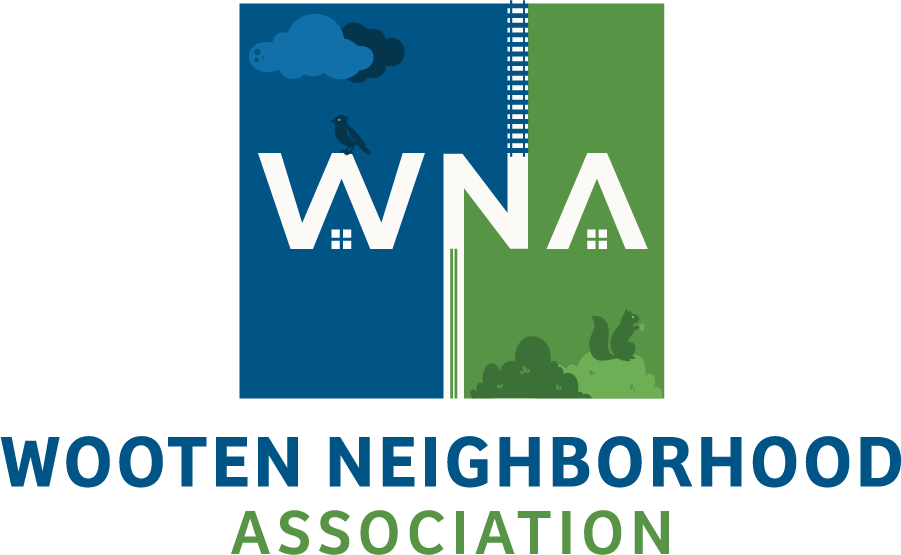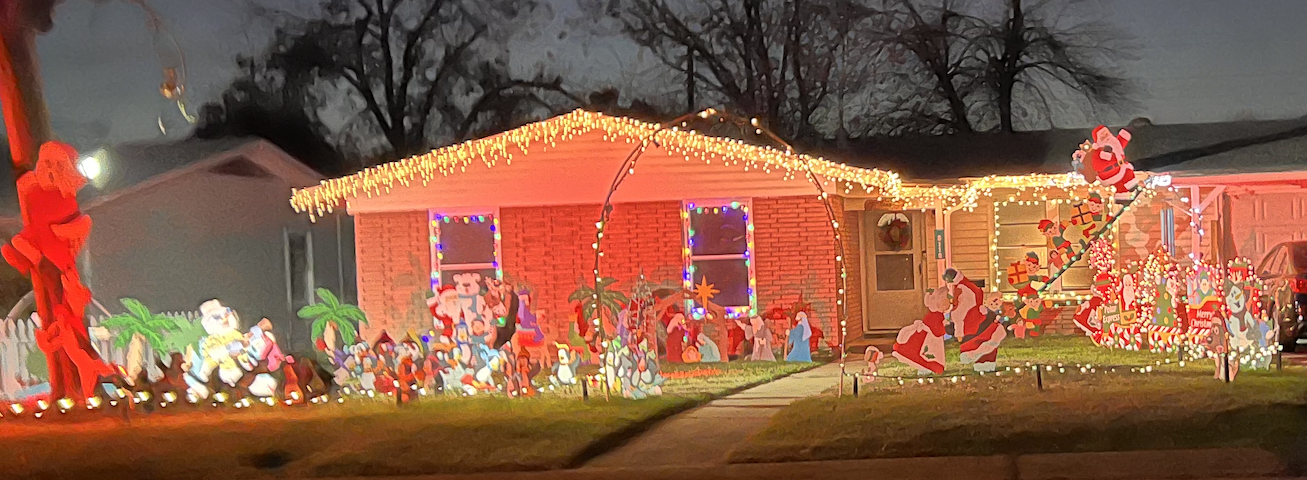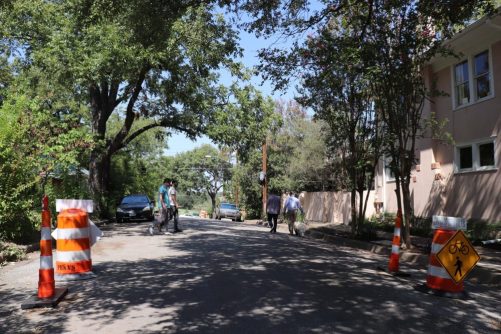Wooten Neighborhood Association
Minutes from the Special WNA Meeting, October 28, 2013
President Chris Gregory called the meeting to order at 7:00pm. He thanked Carolyn Spock and Betsy Thaggard for their work on the issue of the Independent Citizens Redistricting Commission (ICRC) proposal that splits the city into ten districts for purposes of electing city council members.
Chris explained that he and Carolyn had gone to an Allandale neighborhood meeting, and they had been asked for input from Wooten on the issue of how these districts should be drawn. Chris said the two of the them did not feel comfortable speaking for the entire neighborhood without soliciting opinion on the issue first. For this reason, a special meeting was called.
Chris introduced Steven Zettner, who had drafted a proposed resolution that was distributed to those in attendance at the meeting, affirming Wooten’s interest in being a part of a district with four other nearby neighborhoods. Steven is the president of Sustainable Neighborhoods of North Central Austin, which works on growth issues in north Austin. He made clear that while he lives in Allandale, he came to the meeting to speak as an individual and was not representing Allandale or any other group.
Stephen said that Wooten’s main task is to explain to others in the city what makes the community we see ourselves as a part of a “community of common interest.” The other five neighborhoods listed on the proposed resolution (Allandale, Brentwood, Crestview, and Shoal Creek) all agreed to the resolution, although Allandale tweaked it slightly to include Rosedale as well.
Stephen provided some additional background information on the issue. He explained that a successful 2012 ballot initiative changed the city charter to create ten districts across the city, each with about 79,000 people in it, to elect members to the city council. The ICRC has made an initial proposal for how to break up the city into these districts, but is seeking input from Austinites about how to proceed with it.
A group called Austinites for Geographic Representation (AGR), which was part of the effort to pass the ballot initiative, has continued their work in suggesting ways to create these districts. Their mission has been to enfranchise disadvantaged minority groups, and they came out with a map to achieve this goal. Their map includes “minority opportunity districts,” which are districts that are at least 60% Hispanic, in order to meet the federal rules that govern how these districts must be drawn so as not to disenfranchise any minority groups. Steven said that the ICRC seems to have been pretty responsive to AGR’s map.
Steve Rogers commented that because the ICRC has ultimate authority in how to create these ten districts, all WNA can do is to ask them to consider the issues that are most important to Wooten in terms of grouping it with other areas. Steve explained that we have no redress if the commission doesn’t take our advice.
In response to various questions, Steven Zettner said the data about census tract information and demographics aren’t easily available to the public, unfortunately. He also clarified that the population of the five neighborhoods listed on the resolution totals about 28,500 people, which comprises about one-third of a district. In the ICRC’s first proposal, Districts 4 and 7 are the two north Austin districts that could potentially have overlapping interests.
Jon Clegg asked what the advantages and disadvantages of Wooten being a part of either District 4 or District 7 are. Steven said there aren’t huge differences in the two options. However, the other four neighborhoods on the resolution are grouped together in District 7, and our addition could help build up support in one district. On the other hand, Steven said, having a “toehold” in one district even if most of the other neighborhoods are in another district would have its advantages because of the access it would provide to two council members. Adam Turner echoed that in this scenario we could have two council members with constituents of shared interests.
Steven explained that the current District 7 is gerrymandered and very long and narrow, including neighborhoods with little in common; as it stands it’s not a plausible district, and it will likely need to be consolidated.
Teri Newsom asked for more information about what District 4 is like. Steven explained that demographically, Wooten has a lot in common with the current District 4. They share the same school feeder patterns, although there is more crime in District 4 and in Wooten than there is in areas along Burnet Rd. Steven explained that in terms of future growth, the North Lamar area has just as many challenges and opportunities as the Burnet are does, and these corridors are where all the new housing and transportation are going.
Rick Krivoniak commented that he lives in Windsor Park, but he sees a lot of similarities between District 4 and Wooten.
Burton Anderson asked what the popular sentiment north of 183 is on the issue. Steven said that a lot of people are confused by it, but he has heard that neighborhoods north of Parmer see themselves as fairly exurban, and don’t want to be included in areas south of 183. The neighborhoods between Parmer and Braker feel more like Wooten and the other neighborhoods in the resolution. He also said that the people in District 4 seem pretty happy with their district.
There was some confusion about whether Wooten would be split on the ICRC map; Steven explained that this is not the case in the current proposal.
Mary Bedrich commented that the Lamar and Burnet corridors are very different. Jim Bedrich said that the interests of those two corridors will be very different, noting that Wooten’s interests are different than the Hispanic districts’ interests. Mary commented that our area is made up primarily of property owners, while the area around the Lamar corridor is populated mostly by renters.
Steve Rogers commented that one of the original rationales for 10-1 was that many council members came from part of what’s now District 7; with 10-1, Austin would get representation from people who aren’t necessarily residents living near downtown. District 4 does not include any areas near downtown, so representation of that district would be very distinct from what we’ve had in the past, in terms of where council members reside. Steven reminded people that north Austin neighborhoods have different interests from those of downtown. Given that about 18% of council agendas relate to downtown specifically, those issues will take up a council member’s time, as will the paid lobbyists representing downtown interests.
Steven noted that areas north of 45th St. versus areas south of 45th St. are very different demographically. Balanced age demographics is something that defines our district, whereas downtown has very few children, and they really don’t provide housing for families with children. There are also affordability issues that come with that—families can’t afford to live downtown. Thus, if we are put in a district that includes areas near downtown, our council member may be faced with these competing interests.
Linda Ritzen commented on what it would mean if you’re not Hispanic but live in a “Hispanic opportunity district.” It becomes a racial issue because the city chooses to identify the district that way, she said. Josiah Ingalls said that it’s beneficial politically to split homeowners associations across two districts because candidates are often afraid of developers’ influence. He also said that even in districts that are predominantly Hispanic, the voting population is still primarily white. Linda responded that if the city still sees the district as Hispanic, and it will be hard to get rid of that label.
Chris noted that given the current District 7, if Wooten were to be put in District 4, then the Burnet Rd. corridor would be somewhat weakened politically because they will be part of such a gerrymandered district that represents so many others interests.
In response to neighbors’ comments, Steven outlined three concerns he sees as being most important to consider. First, have enough people who feel similarly to you in your district so you can get your council member to do what you want. Second, have a little of your community of interest in another district so you can voice concerns to another council member; however, if your constituency in the second district is too small, it will get ignored. Third, be in a district with fewer competing challenges that take away from what’s important to you (e.g. a district that also includes parts of downtown).
Steven passed around other proposed maps that had been offered by other organizations in the city; it was questionable whether many of these maps would pass legal muster in terms of federal representation requirements. Steven emphasized that the resolution to be voted on this evening does not come with a map that we are proposing.
Betsy asked what the odds are that Wooten would end up in the same district as Tarrytown or other similar areas? Steven said that if the current map changes, the most likely change will be that Tarrytown will be split off from District 7.
Adam asked how the other neighborhoods feel about the resolution. Steven said that all of them agreed, with Allandale tweaking it slightly.
Chris asked for a motion to adopt the resolution. Marilyn said she didn’t know what the resolution was. Adam made a motion to have the resolution read. Chris read the resolution.
Steve Rogers made a motion to pass the resolution. Marilyn seconded the motion. It was announced that anyone in attendance must have been a dues-paying member for 30 days in order to vote; the honor system would be used to enforce this rule. Chris counted 20 votes in favor (note: one voter later wished to withdraw her vote, as she was not a dues-paying member at the time), and none opposed. After members voted, Chris asked for an informal vote of anyone in attendance, including non-members. During this vote, a small handful of people opposed the resolution.
Chris said he would act with this near-unanimous vote in mind when representing Wooten at meetings in the future that deal with this issue. Steven encouraged more people to attend the open ICRC meetings that solicit input from city residents.
Scott Newsom commented that the resolution is reasonable, but it doesn’t encompass the wide range of beliefs in the neighborhood. He said that there are lots of people in the room who would enthusiastically support the Hispanic opportunity zones, and that we should actively engage with the areas that border us, noting how white the group in attendance tonight was.
Steve Rogers explained that WNA meetings have always been very white, and said there was no illusion that WNA represents the population of the neighborhood as a whole. Betsy noted that this was the most people at a WNA meeting perhaps since the Wal-Mart issue. Adam said that there have been efforts to increase the participation at WNA, but that it was difficult in general to get people to attend the meetings. Scott said he was not casting any aspersions on people who were here, but wanted to make the point that we don’t necessarily represent the neighborhood in the resolution.
Joanne Garrett noted that these five neighborhoods in the resolution are still about 50,000-60,000 people short of a district, and asked where the rest of the population might come from. Steven explained that it all depends on the map. The areas north of us are very densely populated, but the areas south of us have higher voter turnout, so Wooten is probably in the middle on both of those measures.
Autumn Righino asked what are our next steps in this process? Chris said he will go to the ICRC meeting on Wednesday, Oct. 30. and explain how WNA had voted on the resolution. Steven said that the final maps are supposed be in by the end of the year, and there will be one or two more meetings for input before then. Josiah said it was very likely that the initial proposal will basically stay the same because the commission is very constrained by the laws.
Steve Rogers commended Chris for being the new WNA president and doing all this work on the issue so far.
Betsy made a motion to adjourn; Victor seconded the motion. The meeting was adjourned at 8:08pm.


